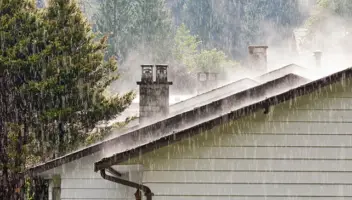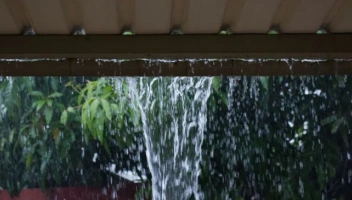How to Clean Your Gutter Downspouts: 5 Steps

Most people don’t enjoy cleaning out their gutters, so they put it off—and who can blame them? There are a lot more enjoyable things to do with your time!
However, if you avoid proper gutter and downspout maintenance, you may soon face the problem of a clogged gutter downspout. This can be dangerous, for as long as the clog exists, it can cause water damage to your home.
In this post, we’ll explain how to clean out your gutter downspouts using tools you likely already have around the house.
In this article:
- What is a Gutter Downspout?
- Signs Your Gutter Downspout is Clogged
- Tools You’ll Need to Clean Out a Gutter Downspout
- 5 Steps to Clean Out Your Gutter Downspout
- Alternative Methods to Clean Out a Gutter Downspout
- How to Prevent Your Gutter Downspouts from Clogging
- Frequently Asked Questions
What is a Gutter Downspout?
A gutter downspout is a vertical pipe attached to your gutter system that directs water down the side of the home and either into the ground or into an “elbow” extension that leads it away from the house.
Gutter downspouts—also called waterspouts, drainpipes, drain spouts, or downpipes—are critical for water drainage. Without them, water would collect inside your gutters until it overflowed, which would negate the reason for having gutters in the first place.
In an efficient gutter system, water moves into the gutters, then flows sideways into the gutter downspouts and drains away. This helps prevent water damage to the home.
In general, you’ll have one gutter downspout for every 40-foot run of gutter. Each gutter downspout is usually made from the same material as the gutters, giving the gutter system a unified look.
Signs Your Gutter Downspout is Clogged
It’s best to clean out your downspouts whenever you clean out your gutters. In general, we recommend cleaning out your gutters at least twice a year—more frequently if your home has a lot of overhanging trees and experiences blowing debris as a result. Sometimes, though, gutter downspouts may get clogged between cleanings, or if you forget or delay a cleaning.
The following signs could indicate your gutter downspout may be clogged:
- Water isn’t flowing out the gutter downspout in a rainstorm.
- Water flows over the edges of your gutters instead of through your gutter downspouts.
- Your gutters are sagging from the weight of water and debris.
- There are leaks in the seams or joints of your gutters or downspouts.
- Water is staining your siding.
- No water flows through the gutter downspout when you test it with a stream of water from a hose.
- You notice leaks and/or water damage in your basement.
Tools You’ll Need to Clean Out a Gutter Downspout
Attention homeowners! 🏡 Did you know that LeafFilter offers FREE estimates for your gutter protection needs? Say goodbye to clogs and hello to peace of mind with LeafFilter!✅ To learn more and get started today, visit https://t.co/6tWbQ0wMvX #ClogFree #FreeEstimate #LeafFilter pic.twitter.com/9JOuBzi7Mp
— LeafFilter Gutter Protection (@LeafFilter) July 18, 2023
Before you start cleaning out your clogged downspout, make sure you have the right tools. You’ll need a few essentials, including:
- Sturdy extension ladder
- Work gloves
- Protective eyewear
- Garden trowel
- Garden hose
- Hand auger
- Helper or assistant
5 Steps to Clean Out Your Gutter Downspout
Once you’ve gathered the necessary tools, take the following steps to clean out your downspout.
1. Remove the gutter downspout extension.
This is the part of the gutter downspout that includes the “elbow” and takes the water away from your house. You want to start here first, as most gutter downspout clogs occur in the elbows. Remove the elbow and the extension if there is one. You may need to loosen and remove a couple of screws.
If your gutter downspout extension is buried underground, we recommend having a professional clean out your downspouts to avoid damage.
2. Clean the extension area.
Put on your gloves and eye protection, then insert a garden trowel into the bottom of the gutter downspout and remove any leaves or debris you can reach. Do this with any elbow extensions, as well.
Then, using a garden hose, spray water up into the downspout to dislodge any remaining debris. Spray it through any elbow pieces, too, but don’t spray it down into a buried section. (This could make an underground clog worse.)
3. Clean the entire gutter downspout from the top.
If you think the gutter downspout is still clogged, carefully place your ladder next to it, climb up, and have a look. Ask a helper nearby to steady the ladder and hand you the hose when you’re ready. (You can also tie a rope to the end of the hose so you can take it with you as you climb.)
Place the end of the hose into the gutter downspout and ask your helper to turn the water on. If water flows out the bottom of the gutter downspout, all is well. Allow it to flow a minute or so to carry out any remaining debris, and you’re done.
If the gutter downspout is still clogged or if water is only trickling down, you’ll need to take additional steps. Start by slowly climbing down the ladder while gently knocking on the side of the gutter downspout as you go. (You can use a broom handle for this.) Then, climb back up the ladder and rinse the downspout out again.
Adding a straight in-line jet nozzle to the end of your hose increases the water pressure to dislodge any stubborn clogs.
4. Use a garden augur tool.
After all this, if water is still not flowing freely through your gutter downspout, you may need to use a handheld garden augur tool. Feed the augur into the downspout opening and turn the drum clockwise. Put it through as far as possible, then pull it back until the clog is loosened.
Use a back-and-forth motion to help break up any blockages. You can also do this from the bottom up if needed.
5. Clean away any remaining debris.
Once the gutter downspout is clean, remove any other leaves and debris that gathered at the bottom so that the water can flow freely at ground level.
Alternative Methods to Clean Out a Gutter Downspout
If the above process doesn’t clean out the gutter downspout clog—or if you would rather try another method—here are some alternatives.
Use a Plumbing Snake
If you have a plumbing snake, insert it into the bottom of the gutter downspout and gently push it up. Be careful, as you don’t want to damage the spout. When you reach the clog, rotate the snake to break up any debris. Then, flush out the spout with a hose.
Use a Power Washer
A power washer will apply more force to a clog than a regular garden hose. If your clog is stubborn and you have a power washer, insert the end into the top of the gutter downspout, then turn on the washer. Debris will likely fly out as you work, so be sure to wear gloves and eye protection.
Use a Wet/Dry Vacuum
The suction ability of a vacuum sometimes works well when cleaning out clogged downspouts. Insert the nozzle into the bottom of the gutter downspout, then turn the vacuum on and see if it will suck the debris away.
How to Prevent Your Gutter Downspouts from Clogging
Cleaning out your gutter downspouts isn’t a fun task—we totally get it! That’s why we recommend preventing clogs from forming inside your gutter downspouts in the first place. Here are a few ways to avoid clogs inside your downspouts:
- Upsizing your gutter downspouts: Installing larger downspouts can help reduce the risk of clogs forming inside them. You can only upsize to what is compatible with the size of your current gutters, however (unless you replace your entire gutter system).
- Add drain covers: Downspout drain covers help block large debris like leaves from going down into the gutter downspout. They look like balls of wire. You can insert the pointed end into the gutter outlet so the ball sticks up into the gutter. Beware, though—debris tends to pile up around these covers, so you’ll have to clean out your gutters more often.
- Add filters: A downspout filter is a device that is installed in the gutter downspout to trap debris. There are several different types. They can help protect your home from water damage, but they also require regular cleaning.
- Commit to monthly inspections: Every month, inspect your gutter downspouts and make sure they are flowing freely. Clean out any clogs you see.
The best way to prevent clogs from forming inside your gutter downspouts is to have LeafFilter gutter guards professionally installed. Our award-winning gutter protection system is designed to keep leaves and debris out of your gutters—which also helps keep your downspouts clog-free. Our patented technology blocks even the smallest debris, including pine needles, shingle grit, and pollen. Call us today for a free estimate at 1-800-290-6106.
Frequently Asked Questions
How do you clean a gutter downspout without a ladder?
Clogs often form in the bottom of the gutter downspout, so you may be able to clean them out by cleaning out the bottom portion. Remove the extension and, using a garden trowel, loosen and remove any debris. If the clog is further up in the gutter downspout, try a wet-dry vacuum with the end inserted into the bottom of the downspout.
A better option is to install a gutter protections system, which keeps leaves and debris out of your gutters and helps to keep your gutter downspouts flowing freely.
How do you maintain gutter downspouts?
The best way to maintain your gutter downspouts is to clean your gutters and downspouts both at least twice a year. In between, regularly check your gutter downspouts to be sure water is still flowing easily through them.
When should you clean gutter downspouts?
It’s best to clean your downspouts at least twice a year. The more leaves and other debris fall into your gutters, the more often you should clean them out. Generally, we recommend cleaning them out once before the winter season sets in and once in the spring.
What happens if a gutter downspout is clogged?
If any of your downspouts become clogged, the water won’t be able to drain. It will back up into the gutters and perhaps even overflow. This can lead to soil erosion and water damage to your home.
Do buried gutter downspouts get clogged?
Some gutter downspouts are buried into the ground to prevent the water from making parts of your lawn wet and muddy. When they’re not buried, downspouts can easily become displaced so that they’re draining water where you don’t want it.
They can also be tripping hazards. Burying your gutter downspout ensures water is redirected away from your home at all times.
If a buried downspout becomes clogged, however, it can be trickier to clean. Check with a professional for help. Don’t wait—a clog inside a buried gutter downspout could lead to flooding in your basement.


